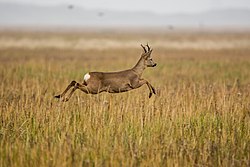Jumping
Jumping is a form of movement in which an organism pushes itself up through the air and falls back down. Jumping is different from running, galloping and other ways of moving because the body is airborne for a longer period of time.
Some animals, such as the kangaroo, use jumping as their main form of traveling, while others, such as frogs, only use it to escape predators. Jumping is also an important feature of many different activities and sports, including the long jump, high jump, and show jumping.
Classification
One way to classify jumping is by looking at how the feet launch and land.[1] In this classification system, there are five basic types of jumping:
- Jump - jumping from and landing on two feet
- Hop - jumping from one foot and landing on the same foot
- Leap - jumping from one foot and landing on the other foot
- Assemble - jumping from one foot and landing on two feet
- Sissonne - jumping from two feet and landing on one foot
| Wikimedia Commons has media related to Lua error in Module:Commons_link at line 62: attempt to index field 'wikibase' (a nil value).. |
Jumping Media
A roe deer jumping, Wadden Sea National Parks
Jumping bottlenose dolphin
A bullfrog skeleton, showing elongate limb bones and extra joints. Red marks indicate bones substantially elongated in frogs, and joints that have become mobile. Blue indicates joints and bones that have not been modified, or are only somewhat elongated.
Grasshoppers store energy for a jump, overcoming the limitations of muscle which cannot contract powerfully and quickly at the same time. Representations of structure are diagrammatic.
Notes
- ↑ Study Guide for Elementary Labanotation by Peggy Hackney, Sarah Manno (Editor), Muriel Topaz (Editor)





